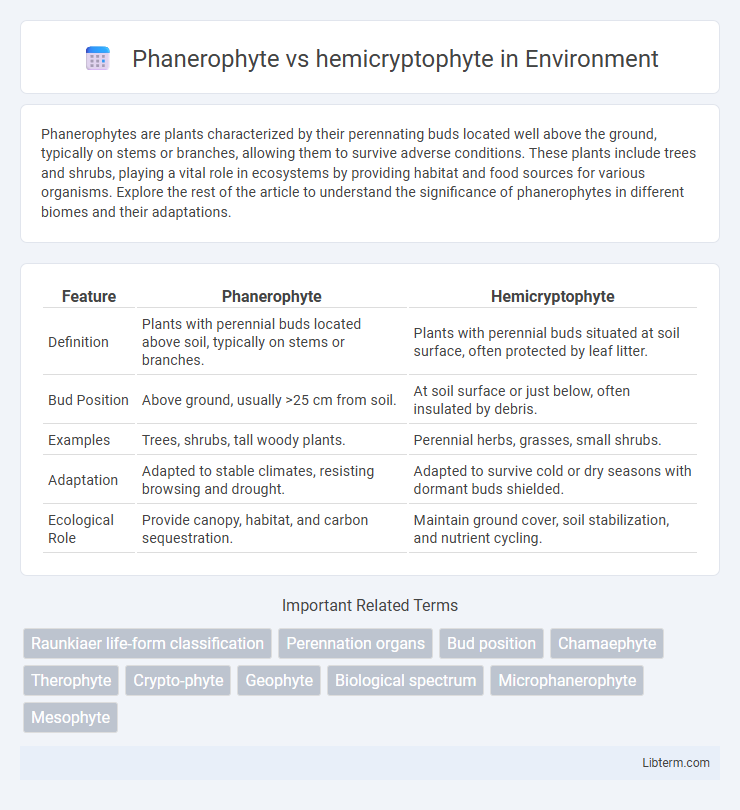Phanerophytes are plants characterized by their perennating buds located well above the ground, typically on stems or branches, allowing them to survive adverse conditions. These plants include trees and shrubs, playing a vital role in ecosystems by providing habitat and food sources for various organisms. Explore the rest of the article to understand the significance of phanerophytes in different biomes and their adaptations.
Table of Comparison
| Feature | Phanerophyte | Hemicryptophyte |
|---|---|---|
| Definition | Plants with perennial buds located above soil, typically on stems or branches. | Plants with perennial buds situated at soil surface, often protected by leaf litter. |
| Bud Position | Above ground, usually >25 cm from soil. | At soil surface or just below, often insulated by debris. |
| Examples | Trees, shrubs, tall woody plants. | Perennial herbs, grasses, small shrubs. |
| Adaptation | Adapted to stable climates, resisting browsing and drought. | Adapted to survive cold or dry seasons with dormant buds shielded. |
| Ecological Role | Provide canopy, habitat, and carbon sequestration. | Maintain ground cover, soil stabilization, and nutrient cycling. |
Introduction to Plant Life Forms
Phanerophytes are plants with perennating buds located well above the soil surface, typically found in trees and shrubs that maintain foliage year-round. Hemicryptophytes have buds situated at the soil surface, allowing them to survive adverse conditions like cold or drought by protecting their growth points. These life forms represent adaptations to environmental conditions, influencing plant survival strategies and ecological interactions.
Defining Phanerophytes
Phanerophytes are perennial plants characterized by their buds located well above the ground, typically more than 25 cm high, making them highly visible throughout the year. These plants include trees and shrubs with woody structures that protect the buds from environmental stress, which contrasts with hemicryptophytes whose buds lie at or just below the soil surface. The elevated position of phanerophytic buds enables better access to sunlight and reduces risks from ground-level herbivory and frost.
Understanding Hemicryptophytes
Hemicryptophytes are perennial plants with buds situated at soil level, enabling survival through adverse seasons such as winter or drought. These plants typically have herbaceous shoots that die back annually, with their regenerative organs protected underground or at ground surface, optimizing resilience in temperate climates. Unlike phanerophytes, which maintain aerial buds on woody stems above ground, hemicryptophytes adapt to environmental stresses by minimizing exposure and conserving energy in dormant structures at or near the soil surface.
Key Morphological Differences
Phanerophytes exhibit perennial buds elevated well above the soil surface, typically on woody stems or branches, allowing them to survive adverse conditions by maintaining active growth points. Hemicryptophytes possess buds located at or just below the soil surface, often protected by soil or leaf litter, enabling them to regrow after environmental stress such as frost or grazing. Phanerophytes generally include trees and shrubs with prominent above-ground structures, while hemicryptophytes comprise mainly herbaceous plants with ground-level survival strategies.
Ecological Adaptations of Phanerophytes
Phanerophytes are woody plants with perennating buds located well above the ground, allowing them to survive harsh climatic conditions by avoiding frost damage and herbivory. Their tall structure and extensive vascular systems enable efficient light capture and water transport, supporting growth in diverse ecosystems including forests and savannas. These ecological adaptations promote competitive advantage for resource acquisition and resilience in environments with seasonal variability.
Hemicryptophyte Survival Strategies
Hemicryptophytes survive harsh climatic conditions by having buds located at the soil surface, protecting them from frost and grazing. Their perennial root systems store nutrients, enabling rapid regeneration during favorable seasons. This survival strategy contrasts with phanerophytes, which keep buds elevated above ground and rely on woody structures for protection.
Distribution and Habitat Preferences
Phanerophytes predominantly inhabit tropical and subtropical regions, thriving in forests and woodlands due to their large, above-ground perennating buds which enable them to survive in stable, warm climates. Hemicryptophytes are more commonly found in temperate and cold climates, especially in grasslands and meadows, where their buds are positioned at soil surface level to resist harsh winter conditions. The differing distribution reflects their adaptations to environmental stresses, with phanerophytes favoring moist, nutrient-rich habitats and hemicryptophytes adapted to withstand seasonal temperature variations and grazing pressures.
Role in Plant Community Dynamics
Phanerophytes, characterized by their perennial woody stems elevated above ground, play a crucial role in plant community dynamics by providing structural complexity and habitat for various fauna, thus influencing biodiversity and microclimates. Hemicryptophytes, with perennating buds at or near the soil surface, contribute significantly to community resilience by rapidly regenerating after disturbances like grazing or fire, stabilizing soil, and maintaining ground-level vegetation cover. The interplay between these life forms shapes successional patterns and ecosystem stability through differential resource use and adaptation to environmental stresses.
Phanerophytes and Hemicryptophytes in Climate Response
Phanerophytes, characterized by their buds located well above ground, demonstrate greater resilience to drought and temperature extremes by accessing deeper soil moisture and maintaining woody structures throughout seasons. Hemicryptophytes, with buds at or just below the soil surface, are better adapted to survive harsh winters and frequent disturbances by relying on underground storage organs and seasonal dieback. These distinct growth forms influence their climate responses, with phanerophytes dominating in stable, warmer environments, while hemicryptophytes prevail in colder or more variable climates.
Importance in Biodiversity and Conservation
Phanerophytes, characterized by their woody stems and long lifespan, contribute significantly to habitat structure and biodiversity by providing essential resources and shelter for various fauna. Hemicryptophytes, with their adaptation to survive unfavorable seasons through soil-level buds, play a crucial role in ecosystem resilience and plant community dynamics, especially in temperate regions. Understanding the ecological functions of both growth forms aids conservation strategies focused on maintaining plant diversity and ecosystem stability.
Phanerophyte Infographic

 libterm.com
libterm.com